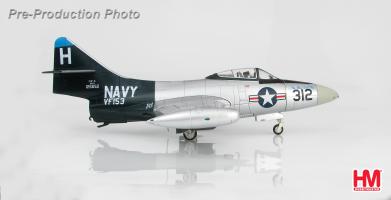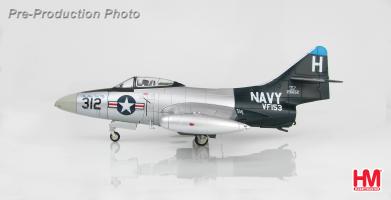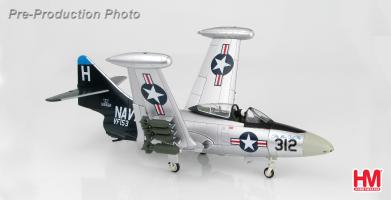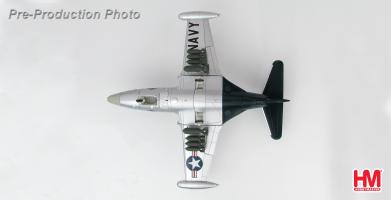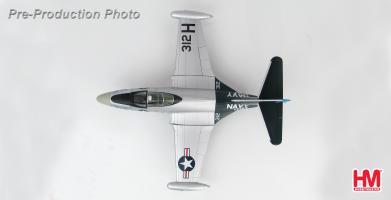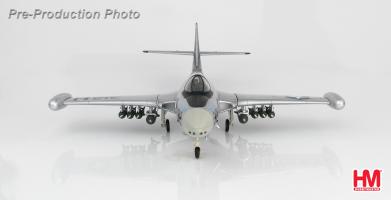Hobby Master Archive
Air Power Jets 1/48
F9F Panther
Grumman F9F-5 "Blue Tail Fly" 126652, VF-153, USS Princeton, 1953
Hobby Master 1/48 Air Power Series HA7208 Grumman F9F-5 “Blue Tail Fly” 126652, VF-153, USS Princeton, 1953
Die-cast metal with a minimum of plastic.
All markings pad applied for superb results.
Cockpit slides open.
Pilot figure.
Comes with display stand.
Landing gear is fully retractable and can be displayed up or down.
Wings can fold and unfold.
Extremely sought after by collectors.
Powered by a Rolls-Royce engine the first F9F flew in 1947. These new engines were fuel hungry and with no extra internal space permanent wing-tip tanks were added. These tanks also had the unexpected benefit of increasing the aircraft roll rate. In the Korean War the F9F was the primary USN aircraft for ground-attack and served with distinction. However it was realized that the Panther was inferior to the MiG aircraft so a swept-wing version was developed. The new aircraft retained the F9F designation and was called the Cougar.
Two Grumman F9F Panthers from VF-153 suffered AA fire damage. One Panther wore a natural metal finish and had its tail section destroyed while 126652 wore a glossy sea blue scheme and had its forward section destroyed so it was decide to mate the good sections from each aircraft to produce one airworthy Panther, 126652 the “Blue Tail Fly”. The unique aircraft flew 12 missions in this configuration before being sent for a complete rebuild returning to service with VF-63 and later VMF-115, VMF-311, VMA-224 and in 1958 placed in storage.
Specifications for the Grumman F9F-5 Panther Crew - (1) pilot Performance Engine - (1) Pratt & Whitney J48-P-4/P-6A turbojet @ 6,250 lb.s.t. Internal fuel capacity - 1,003 US gallons Maximum speed - 604 mph @ sea level, 579 mph @ 5,000 ft, 543 mph @ 3,500 ft Cruising speed - 481 mph Stalling speed - 132 mph Initial climb rate - 5,090 fpm Service ceiling - 42,800 ft. Range - 1,300 miles.
Dimensions Wingspan - 38 ft 0 in Length - 38 ft 10 1/2 in Height - 12 ft 4 in Wing area - 250 sq ft Weights Empty - 10,147 lbs Gross - 17,766 lbs Maximum takeoff - 18,721 lbs Armament (4) 20-mm cannon in the nose (8) Under wing hard points could accommodate up to 3,465 lbs. of bombs and rockets
| Added to archive | 2018-01-10 |
| Last modified | 2018-01-10 |
| Leaflet | 2018-02-01 February 2018 |
